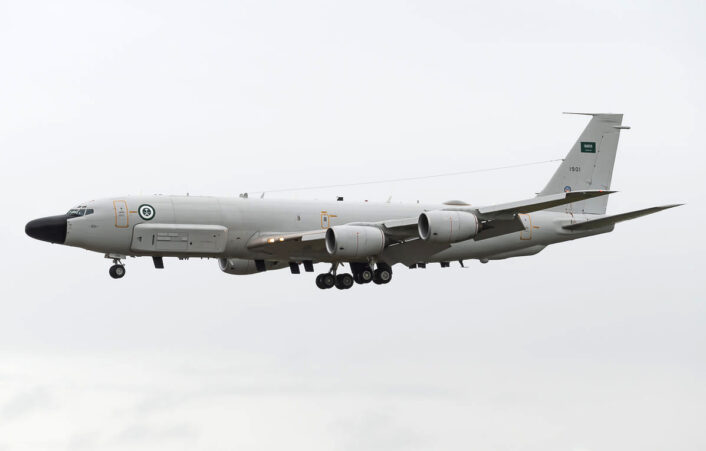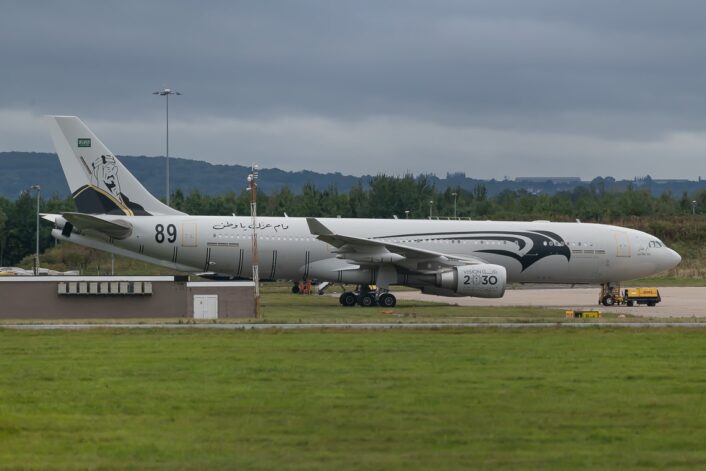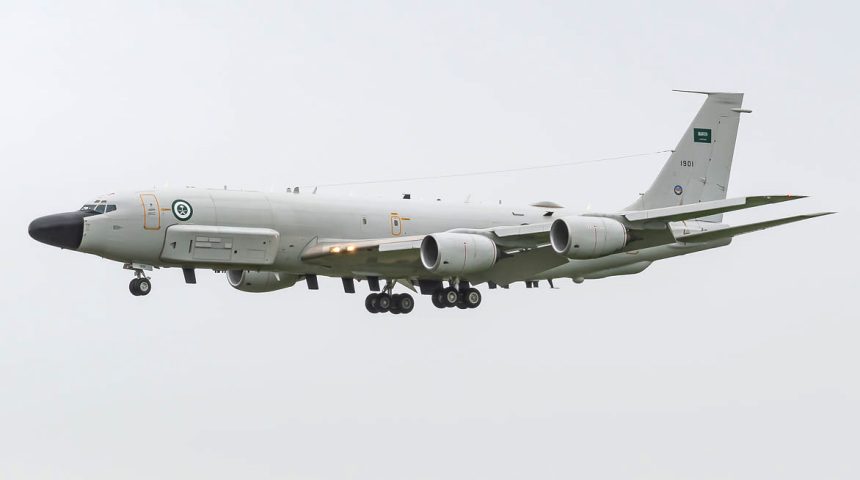The Royal Saudi Air Force Boeing RE-3A TASS (Tactical Airborne Surveillance System) supported by a Saudi A330 MRTT is reportedly on its way to the U.S. for rework.
A Royal Saudi Air Force (RSAF) RE-3A signals intelligence (SIGINT) aircraft arrived at RAF Waddington, UK, on Sept. 30, 2021. Using radio callsign RSF1077, the aircraft, serial number 1901, arrived straight from Prince Sultan Air Base, in central Saudi Arabia, home of the RSAF’s 19th Squadron, with support tanker A330-MRTT, serial 2405, RSF 1078, which landed at East Midlands airport wearing the 89th anniversary scheme.
The photos of the Saudi SIGINT aircraft you can find in this post were taken by our friend and photographer Martin Fox.
The RE-3 is a super rare aircraft. Just three such aircraft are known to be in service. Two, including the airframe 1901, are RE-3A TASS (Tactical Airborne Surveillance System), while one is an RE-3B Improved Tactical Airborne Surveillance System (ITASS) aircraft, serialled 1902.
Although this has not been confirmed yet, the aircraft, that is quite similar to the Baseline 11 standard U.S. Air Force RC-135V/W Rivet Joint (and RAF RC-135W Airseeker), was on its way to the U.S. where it will probably undertake maintenance/upgrade works.
The RE-3A belongs to a batch of eight KE-3A tankers the RSAF received in 1986 and delivered, along with five E-3A Sentry AWACS (Airborne Warning And Control Systems), as part of the “Peace Sentinel” program.

According to aerospace writer and journalist Jon Lake, the seventh tanker, was delivered to Raytheon Intelligence, Information and Services (the former E-Systems) at Majors Field, Greenville, Texas, where it was converted to become an RE-3A SIGINT platform, equipped with the Raytheon TASS. After the conversion to the RE-3A standard, the aircraft flew again to the U.S. for additional upgrades in December 2001 and was finally re-delivered to the RSAF in January 2004.
The conversions were managed on the RSAF’s behalf by the U.S. Air Force 645th Aeronautical Systems Group, also known as Big Safari special projects office (responsible for most USAF SIGINT and ISR programmes). While missing the distinctive “hog nose” of the American Rivet Joint, the Saudi spyplane sported similar “cheek” fairings and ventral antennas.
In 2009, the U.S. approved the upgrade of the RE-3s as part of a program worth 530M USD with L-3 Communications Integrated Systems Company in Greenville, TX, as main contractor.
The upgrades included the “installation of 10 AN/ARC-230 High Frequency Secure Voice/Data Systems, 25 AN/ARC-231 or 25 AN/ARC-210 Very High Frequency/Ultra High Frequency (VHF/UHF) Secure Voice/Data Systems, four Multifunctional Information Distribution System-Low Volume Terminals (MIDS-LVT), four LN-100GT Inertial Reference Units, 25 SY-100 or functional equivalent Crypto Systems, seven SG-250 or functional equivalent Crypto Systems, six SG-50 or functional equivalent, 10 CYZ-10 Fill Devices, modification of existing ground stations, TASS equipment trainer, mission scenario generator (simulator), and maintenance test equipment; spare and repair parts, support and test equipment, personnel training and training equipment, publications and technical documentation including flight/operator/maintenance manuals, modification/construction of facilities, U.S. Government and contractor engineering and support services and other related elements of logistics support.”
According to the U.S. DSCA (Defense Security Cooperation Agency) upgrades would enable the Royal Saudi Air Force (RSAF) to sustain their capability, maintain interoperability with USAF and other coalition forces, and provide flexibility options for future growth. “The upgrade will enhance the RSAF’s ability to use a common architecture for efficiently communicating the gathered electronic data, within the RSAF and with other regional coalition forces.”
Images of the RE-3A taking part in a flypast at the end of the multi-national Gulf Shield military exercise in April 2018 revealed the new “look” of the Saudi SIGINT aircraft that was eventually given the “hog nose” along with revised dorsal and ventral antenna farms. Those antennas are used by the aircraft to eavesdrop enemy signals, transmissions, detect frequencies used by radio and radars and pinpoint sites of interest, mobile stations, SAM batteries, etc. In other words, the aircraft is an intelligence gathering platform that can help to “build” the enemy EOB (Electronic Order of Battle) so as to achieve the so-called Information Superiority. As done by the RSAF RE-3s in the war against Houthi rebels in Yemen.










